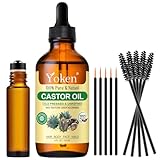Table of Contents
We’ve all experienced those nagging muscle aches that just won’t quit. As cat lovers, we know how important it is to find natural remedies that are safe for both us and our feline friends. That’s why we’re excited to share our knowledge about castor oil for muscle pain. This versatile oil has been used for centuries to relieve discomfort, and we’ve seen firsthand how it can work wonders for back muscle pain and overall soreness.
In this article, we’ll explore how to use castor oil for muscle pain and why it’s so good for soothing those achy spots. We’ll dive into the properties that make castor oil relax muscles and talk about how to apply it effectively. Plus, we’ll share some tips on using castor oil after workouts to help with recovery. Whether you’re dealing with chronic pain or just looking for a natural way to ease muscle tension, we’ve got you covered with all the info you need to get started with this amazing remedy.
- EWG Verified Organic,100% Pure: Yoken organic castor oil is proudly EWG Verified to meet the most rigorous standards and ultimate quality, is cold pressed from castor seeds of India, Virgin, Unrefined, Hexane Free, Cruelty Free, Single Ingredient Oil
- Castor Oil in Dropper Glass Bottle: Our castor oil comes in an amber glass bottle, the thick glass material can well retain its rich omega and ricinoleic acid, and the amber color can effectively protect the integrity of the oil and block sunlight
- Castor Oil for Eyelashes, Eyebrows & Hairs: Cold pressed organic castor oil full of nourishing fatty acids and vitamins, supports stronger fuller-looking hair, lashes and brows. Comes with eyelash and eyebrow kit, allowing easily apply this serum oil
- Natural Skin Moisturizer: Organic golden castor oil has a rich viscous texture that can penetrate deep nourish your face, nails, and body. Pure caster oil helps to hydrate dry skin & fine lines. Bonus roller bottle for mess-free and quick application
- How To Use: Castor oil hexane free is a multipurpose and ultimate skincare ingredient, perfect as a carrier oil for essential oil mixing, you can combine it with other skin-friendly oil, such as jojoba oil, for DIY hair masks, massage oil, nail care
- Castor Oil Glass Bottle: Our premium organic castor oil is elegantly packaged in a dark glass bottle, which protects against light exposure that can degrade its delicate fatty acids and antioxidants—ensuring maximum freshness and nutrient retention for your hair, skin, and nails.
- Cold Pressed Hexane Free Organic Castor Oil: Sourced from the finest organic castor beans and extracted via cold pressing—with no hexane or harsh solvents—this oil delivers a clean, potent infusion of essential fatty acids that deeply moisturize and nourish from root to tip.
- Golden Castor Oil: Our golden castor oil is unrefined and pure, boasting a rich amber hue and a high concentration of ricinoleic acid, which helps condition hair, soften skin, and strengthen nails for a radiant, healthy-looking glow.
- Castor Oil for Hair Growth: Naturally high in ricinoleic acid, this castor oil for hair growth penetrates the scalp to boost circulation around hair follicles, replenishing moisture, reducing breakage, and creating an optimal environment for stronger, fuller hair.
- Trusted Quality: Crafted under rigorous quality controls and USDA-certified organic standards, our chemical‑free formula is rigorously tested for purity—hexane‑free and 100% unadulterated—so you can trust you’re getting the highest grade castor oil available.
- SORE MUSCLE MASSAGE OIL FOR MASSAGE THERAPY – Our 100% Natural formula, expertly crafted to help alleviate tired, aching muscles. With its easy absorption and natural aroma, this oil helps eases tension while leaving your skin feeling deeply nourished and moisturized.
- ARNICA OIL & PEPPERMINT OIL – Both possess soothing properties that make them beneficial for muscle relief. Combining these two oils helps provide a synergistic effect, offering both immediate relief from discomfort and long-term benefits for muscle recovery and relaxation.
- MADE WITH ALL-NATURAL POWERFUL INGREDIENTS – Made with a blend of all-natural ingredients, including Arnica Extract, Lavender Oil, Peppermint Oil & Chamomile Oil specifically designed to targets sore muscles and joints while inducing relaxation.
- NON-GREASY & LIGHTWEIGHT – This fast-absorbing formula, effortlessly melts into the skin for a silky-smooth texture. Infused with a refreshing mint scent our massage oil with its natural soothing aroma, bids farewell to greasy residues.
- CRUELTY, PARABEN, SULFATE, AND PHTHALATE FREE – This massage oil for sore muscles is cruelty-free and made with clean ingredients, so that we can ensure a safer and more ethical choice for our customers, promoting both their well-being and that of the environment.
- Deep Muscle Relaxation: A warming and soothing blend of essential oils to ease sore muscles after strenuous activities or a long day spent in front of the computer:
- Encourage Feelings Of Calm: Thi blend includes aromatic essential oils that support a peaceful and tranquil mood to help you unwind after a tough day.
- Boosts The Complexion: It is packed with antioxidant-rich natural oils that reduce the appearance of blemishes and discoloration for a radiantly glowing complexion.
- Abundant Aromatherapeutic Benefits: While the relaxing oils in this blend give your muscles the ultimate comfort, their exotic aromas support soothed senses and feelings of clear breathing.
- Made And Packaged In The USA: This hexane-free roll on is responsibly formulated with pure and natural oils that are without harsh chemicals, toxins, and additives.
- Majestic Pure Sore Muscle Massage Oil is designed specially so you can look and feel your best.
- Infused with chamomile and lavender oils in addition to arnica, this massage oil combines their soothing properties to help support muscle health.
- Ideal for massage therapy, this oil promotes relaxation, making it perfect for post-workout recovery or everyday muscle relaxation.
- Unscented and gentle on the skin, this oil is suitable for all bodies and skin types and is very quickly absorbed.
- Premium quality: We are proud to present high quality, PETA certified products featuring potent and pure plant extracts to help you feel your best.
Understanding Castor Oil and Its Properties
As cat lovers, we’re always on the lookout for natural remedies that are safe for both us and our feline friends. That’s why we’re excited to share our knowledge about castor oil. This amazing oil comes from the seeds of the Ricinus communis plant, which is common in Eastern parts of the world. We’ve found that castor oil is packed with benefits, thanks to its unique chemical makeup.
The star of the show is ricinoleic acid, which makes up about 90% of castor oil’s fatty acid content. This special compound is what gives castor oil its anti-inflammatory and pain-relieving properties. We’ve seen firsthand how it can help soothe sore muscles and achy joints.
In our experience, castor oil is gentle on the skin and doesn’t cause irritation, making it perfect for repeated use. It’s also great for creating a moist environment that promotes healing. We even use it in our own home remedies for various ailments.
Preparing and Applying Castor Oil for Muscle Pain Relief
We’ve found that making a castor oil pack is a great way to alleviate muscle pain. Here’s how we do it:
- Cut a piece of cotton flannel or cloth into a 12×10 inch rectangle.
- Pour castor oil into a container and soak the cloth completely.
- Place the oil-soaked cloth on the affected area.
- Cover with a plastic sheet to protect clothing and retain heat.
- Apply a heating pad over the plastic for added warmth.
We usually leave the pack on for about 45 minutes to an hour. After removing it, we wipe the area clean with a warm, damp towel. For best results, we repeat this process 4-5 times a week.
In our experience, castor oil can also be applied directly to sore muscles. We gently massage it into the affected area, making sure to cover the entire inflamed region. This method has worked wonders for us after intense workouts!
Enhancing the Effectiveness of Castor Oil Treatments
We’ve discovered some great ways to boost the effectiveness of castor oil for muscle pain relief. One method we love is using castor oil packs. To make one, we soak a piece of cotton or wool fabric in castor oil and apply it to the sore area. For added benefit, we place a plastic sheet over the pack to retain heat. Sometimes, we even add a hot water bottle or heating pad on top for extra warmth.
In our experience, combining castor oil with other natural remedies can work wonders. We’ve had success mixing it with a few drops of rosemary or lavender oil. This blend not only smells amazing but also enhances the soothing properties of castor oil.
When applying castor oil, we always make sure to massage it gently into the skin. This helps improve circulation and allows the oil to penetrate deeper. We’ve found that this simple step can make a big difference in pain relief.
Final Thoughts – Is Castor Oil Good For Muscles?
Castor oil has proven to be a versatile and effective remedy for muscle pain relief. Its anti-inflammatory properties, combined with various application methods, make it a valuable tool to ease discomfort and promote healing. We’ve seen firsthand how this natural solution can work wonders for sore muscles, whether used as a pack or massaged directly into the skin. Our personal experience with castor oil has been truly eye-opening, as it’s helped us recover faster from intense workouts and alleviate chronic aches.
Looking ahead, the potential of castor oil to complement traditional pain management techniques is exciting. Its gentle nature and lack of side effects make it an attractive option for those seeking natural alternatives. As we continue to explore the benefits of castor oil, we encourage others to give it a try and experience its soothing effects for themselves. Remember, while castor oil can be a helpful tool, it’s always best to consult with a healthcare professional for persistent or severe muscle pain.
FAQs
How should castor oil be applied to relieve muscle pain?
To alleviate muscle pain with castor oil, you can either massage the oil directly onto the affected area, ensuring it covers the entire inflamed region or use a castor oil pack. For the pack, soak a piece of cloth in castor oil and place it on the sore area.
Is it safe to apply castor oil to an open wound?
Castor oil can be beneficial for wound healing due to its antibacterial and antimicrobial properties. It’s often used in formulations like Venelex, combined with balsam Peru, to treat skin and pressure wounds. However, it’s essential to consult healthcare professionals before applying it directly to open sores.
Can castor oil help repair nerve damage?
Castor oil is known for its strong anti-inflammatory properties, which can be effective in treating pain and inflammation from nerve damage, such as a pinched nerve. Its application might help in restoring nerve function.
How do you make a castor oil compress?
To create a castor oil compress, fold a large piece of flannel (about 12”x27”) into three layers. Place this folded flannel into a large mason jar and gradually add castor oil, a few tablespoons at a time, allowing it to absorb into the cloth until it is fully saturated.







